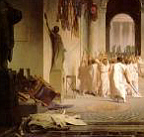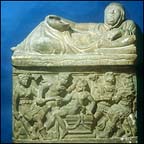
Well, I got back from Portland (OR) in time to watch the "Who Killed Julius Caesar?" program on the Discovery Channel last night. I found it interesting that the investigator used reenactments to determine how many actual conspirators stabbed Caesar. From the reenactments he determined that no more than 5 to 10 people could have had close enough access to Caesar during the killing frenzy. In fact he estimates the number closer to 5 since 10 people stabbing wildly with daggers would have probably inflicted more wounds. He expressed his opinion that the rest of the conspirators were probably engaged in keeping the other senators back--in other words, crowd control.
Although Cassius motives were clearly explained, the investigator went on to study Caesars own behavior and eventually concluded that the conspirators simply played into Caesars own hands as his instruments to end his life in such a way as to ensure his designated successor and "immortalize" Caesar for all posterity. His "contrived suicide" theory was based on several incidents and observations. The most convincing evidence, from his perspective, was a public indescretion in which Caesar refused to rise for a group of senators that approached him with a proclamation deifying him. He referred to a passage by Suetonius but also mentioned a passage in Plutarch in which Caesar was described as having a "fit" then, tearing his toga open, demanding that the Senators kill him now and that he would not resist. He also pointed out that Dio said Caesars supporters had claimed he had loose bowels and was afraid of disgracing himself if he tried to stand. He said this indicated how ill Caesar really was.
This all appears to be a little convoluted. I found the passage in Suetonius about the refusal to rise for an honor (not described as deification): "But it was the following action in particular that roused deadly hatred against him. When the Senate approached him in a body with many highly honorary decrees, he received them before the temple of Venus Genetrix without rising. Some think that when he attempted to get up, he was held back by Cornelius Balbus; others, that he made no such move at all, but on the contrary frowned angrily on Gaius Trebatius when he suggested that he should rise." - Suetonius, De Vita Caesarum, Divus Iulius, Book LXXVII
I also found a passage in Plutarch about Caesar telling a group of Senators to go ahead and kill him but it was following the Lupercalia incident with Antony and the diadem: "...twining a garland of bay round a diadem, he ran up to the Rostra, and, being lifted up by his companions, would have put it upon the head of Caesar, as if by that ceremony he were declared king. Caesar seemingly refused, and drew aside to avoid it, and was applauded by the people with great shouts. Again Antony pressed it, and again he declined its acceptance. And so the dispute between them went on for some time, Antony`s solicitations receiving but little encouragement from the shouts of a few friends, and Caesar`s refusal being accompanied with the general applause of the people; a curious thing enough, that they should submit with patience to the fact, and yet at the same time dread the name as the destruction of their liberty. Caesar, very much discomposed at what had past, got up from his seat, and, laying bare his neck, said, he was ready to receive the stroke, if any one of them desired to give it."
The I found the diarrhea passage in Dio: "when once they had voted to him on a single day an unusually large number of these honours of especial importance--which had been granted unanimously by all except Cassius and a few others, who became famous for this action, yet suffered no harm, whereby Caesar's clemency was conspicuously revealed--they then approached him as he was sitting in the vestibule of the temple of Venus in order to announce to him in a body their decisions; for they transacted such business in his absence, in order to have the appearance of doing it, not under compulsion, but voluntarily. And either by some heaven-sent fatuity or even through excess of joy he received them sitting, which aroused so great indignation among them all, not only the senators but all the rest, that it afforded his slayers one of their chief excuses for their plot against him. Some who subsequently tried to defend him claimed, it is true, that owing to an attack of diarrhoea he could not control the movement of his bowels and so had remained where he was in order to avoid a flux. They were not able, however, to convince the majority, since not long afterwards he rose up and went home on foot; hence most men suspected him of being inflated with pride and hated him for his haughtiness, when it was they themselves who had made him disdainful by the exaggerated character of their honours."
The investigator also said Caesar appeared to provoke the conspirators by other actions such as wearing purple--the historical dress of kings.
However, Cassius Dio says: "First, then, they voted that he should always ride, even in the city itself, wearing the triumphal dress, and should sit in his chair of state everywhere except at the games;" Dio goes on, "As he seemed to like all this, a gilded chair was granted him, and a garb that the kings had once used." Dio continues, "When he showed himself pleased with these honours also, they accordingly voted that his golden chair and his crown set with precious gems and overlaid with gold should be carried into the theatres in the same manner as those of the gods, and that on the occasion of the games in the Circus his chariot should be brought in. And finally they addressed him outright as Jupiter Julius and ordered a temple to be consecrated to him and to his Clemency, electing Antony as their priest like some flamen Dialis."
So, Caesar's wearing apparel seemed to be dictated by the Senate, not necessarily by Caesars own whim.
The investigator also consulted a forensic psychologist who suggested that Caesars behavior indicated he may have suffered from temporal epilepsy. He said Caesars voracious sexual appetite, voluminous writings, and increasing airs of superiority would be consistent with a person suffering from this condition. He explained that temporal epilepsy only grows worse over time and Caesar may have feared he would eventually lose physical control and his precious dignitas if his condition continued to worsen.
The investigator also pointed out that Caesars autopsy revealed that he clutched the very note warning him of the assassination. The investigator could not believe that he did not read it despite what the ancient sources said.
The thing that confuses me, though, is if Caesar intended to be killed, why did he hesitate after learning of all the bad omens and thinking about his and Calpurnias warning dreams? Even Dio says he had to be persuaded to go to the senate house by Decimus Brutus:
"He was warned of the plot in advance by soothsayers, and was warned also by dreams. For the night before he was slain his wife dreamed that their house had fallen in ruins and that her husband had been wounded by some men and had taken refuge in her bosom; and Caesar dreamed he was raised aloft upon the clouds and grasped the hand of Jupiter. Moreover, omens not a few and not without significance came to him: the arms of Mars, at that time deposited in his house, according to ancient custom, by virtue of his position as high priest, made a great noise at night, and the doors of the chamber where he slept opened of their own accord. Moreover, the sacrifices which he offered because of these occurrences were not at all favourable, and the birds he used in divination forbade him to leave the house. Indeed, to some the incident of his golden chair seemed ominous, at least after his murder; for the attendant, when Caesar delayed his coming, had carried it out of the senate, thinking that there now would be no need of it. "
"Caesar, accordingly, was so long in coming that the conspirators feared there might be a postponement--indeed, a rumour got abroad that he would remain at home that day--and that their plot would thus fall through and they themselves would be detected. Therefore they sent Decimus Brutus, as one supposed to be his devoted friend, to secure his attendance."
Maybe embracing this relatively modern suicide theory made the program more sensational to increase the viewership.
 "Goddess," the new exhibit at the Costume Institute of the Metropolitan Museum of Art in New York, aims to convince museumgoers that fashion, no matter how ephemeral, has remained consistently under the spell of Greco-Roman imagery from the French Revolution right through to the spring 2003 runway collections. The impact of classical dress on modern fashion is translated in the popular imagination to mean long fluted gowns, off-the-shoulder silhouettes and endless yards of draped chiffon.
"Goddess," the new exhibit at the Costume Institute of the Metropolitan Museum of Art in New York, aims to convince museumgoers that fashion, no matter how ephemeral, has remained consistently under the spell of Greco-Roman imagery from the French Revolution right through to the spring 2003 runway collections. The impact of classical dress on modern fashion is translated in the popular imagination to mean long fluted gowns, off-the-shoulder silhouettes and endless yards of draped chiffon.
 Well, I got back from Portland (OR) in time to watch the "Who Killed Julius Caesar?" program on the Discovery Channel last night. I found it interesting that the investigator used reenactments to determine how many actual conspirators stabbed Caesar. From the reenactments he determined that no more than 5 to 10 people could have had close enough access to Caesar during the killing frenzy. In fact he estimates the number closer to 5 since 10 people stabbing wildly with daggers would have probably inflicted more wounds. He expressed his opinion that the rest of the conspirators were probably engaged in keeping the other senators back--in other words, crowd control.
Well, I got back from Portland (OR) in time to watch the "Who Killed Julius Caesar?" program on the Discovery Channel last night. I found it interesting that the investigator used reenactments to determine how many actual conspirators stabbed Caesar. From the reenactments he determined that no more than 5 to 10 people could have had close enough access to Caesar during the killing frenzy. In fact he estimates the number closer to 5 since 10 people stabbing wildly with daggers would have probably inflicted more wounds. He expressed his opinion that the rest of the conspirators were probably engaged in keeping the other senators back--in other words, crowd control.
 The symposium, "The Etruscans Revealed: New Perspectives on Pre-Roman Italy," was held in conjunction with the opening of a new gallery of Etruscan antiquities at the universitys Museum of Archaeology and Anthropology.
The symposium, "The Etruscans Revealed: New Perspectives on Pre-Roman Italy," was held in conjunction with the opening of a new gallery of Etruscan antiquities at the universitys Museum of Archaeology and Anthropology.